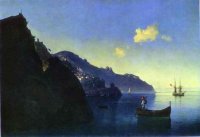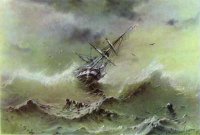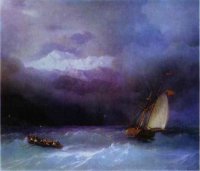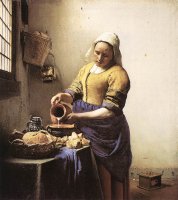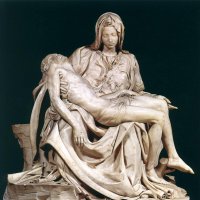I've always been drawn to this one, for some reason.
The Milkmaid
by Vermeer van Delft
c. 1658
Oil on canvas, 45,5 x 41 cm
Rijksmuseum, Amsterdam
Signature: Not signed.
Provenance: This picture ranges among the most highly appreciated paintings by Vermeer, since shortly after his demise and also in subsequent years, second only to his View of Delft. It also fetched the second highest price in the Amsterdam sale of 1696, no. 2: "A maid pouring out milk, extremely well done, by ditto, fl 175." The price is reasonable, given the mediocre level at which his paintings traded. The work never left Holland, and its attribution to Vermeer was upheld throughout. Slankert enumerates various Amsterdam sales in which the Milkmaid is mentioned and highly spoken of, until the canvas became part of the Six collection, Amsterdam, in the earlier part of the nineteenth century. It was acquired by the museum in 1907-8 from this source.
Although the genre of "kitchen pieces" belongs to a long tradition in the Netherlands, with Joachim Beuckelaer and Pieter Aertsen in the sixteenth century being its initiators, it lost favour in the subsequent century, with the exception of Delft, where it endured. Vermeer's realization, however, has nothing in common with his archaic forerunners. His vision is concentrated on a single sturdy figure, which he executes in a robust technique, in keeping with the image that he wants to project. The palette features a subdued colour scheme: white, yellow, and blue. But the colours are far from frank or strident, and are rather toned down, in keeping with the worn work clothes of his model.
The still life in the foreground conveys domestic simplicity, and the light falling in from the left illuminates a bare white kitchen wall, against which the silhouette of the maid stands out. One gains from this deceptively simple scene an impression of inner strength, exclusive concentration on the task at hand, and complete absorption in it. The extensive use of pointillé in the still life lets us presume the use of the inverted telescope in an effort to set off this part of the painting against the main figure and alert the viewer to the contrast between the active humanity of the maid and her inanimate environment.

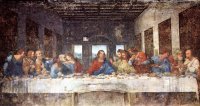
 I do enjoy many of those different ones you come across at times, but the classics are still my favorites.
I do enjoy many of those different ones you come across at times, but the classics are still my favorites. 
